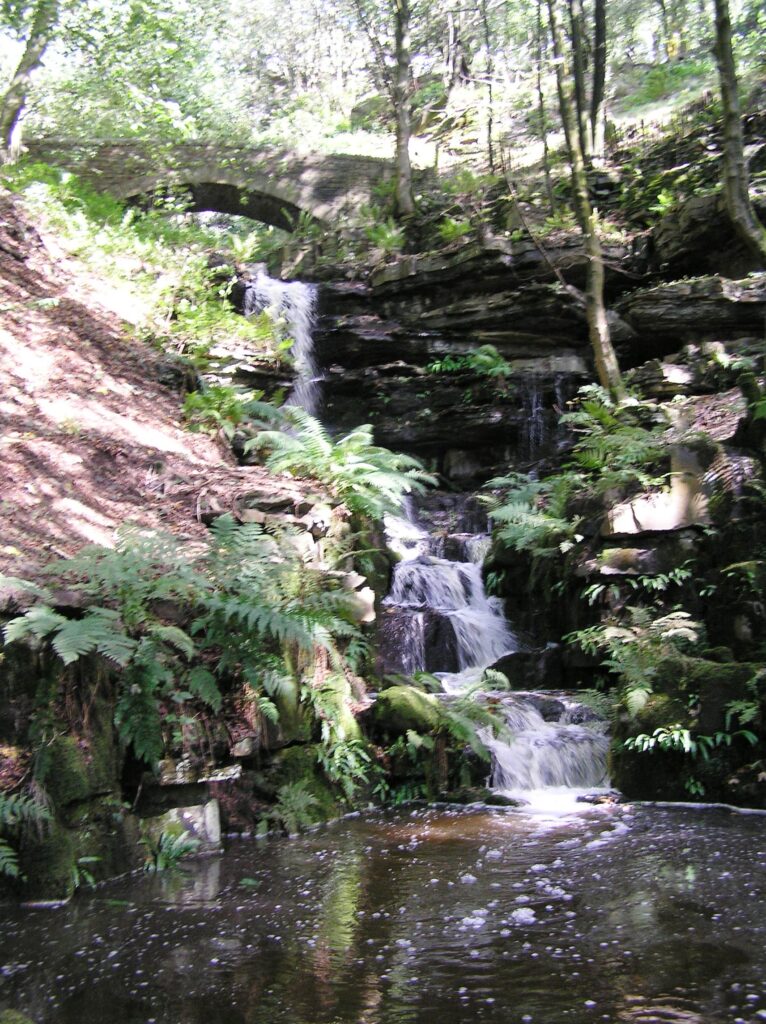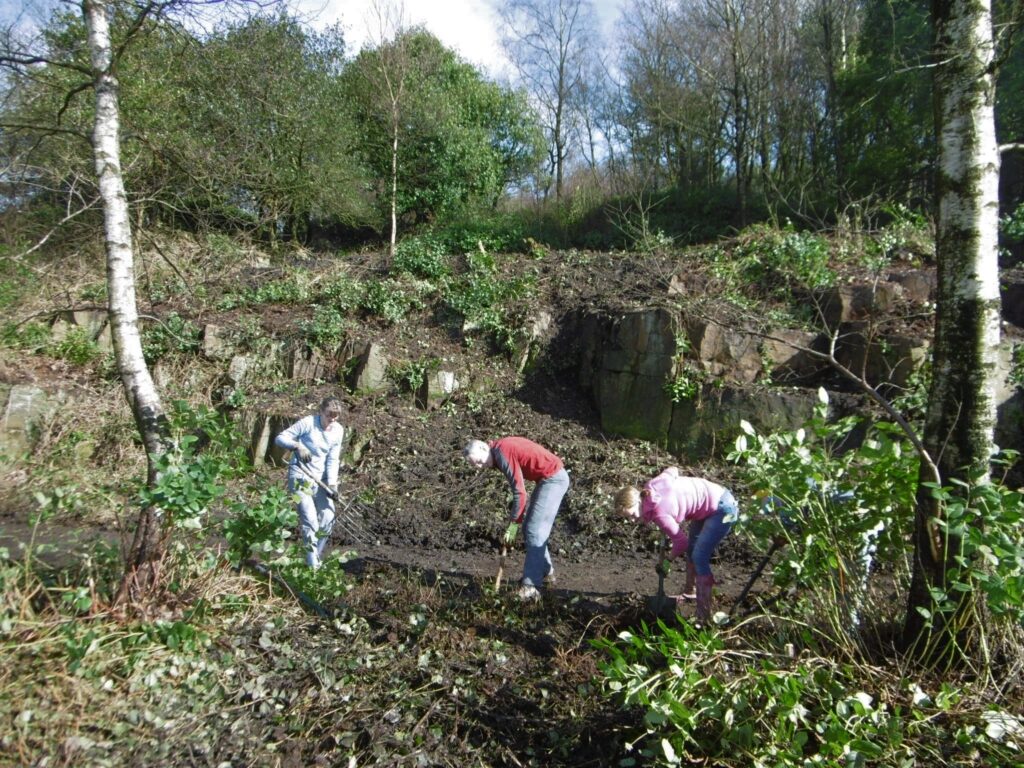Rivington Terraced Gardens in Lancashire, Unforgettable Garden of the Month by Elaine Taylor, Lancashire Gardens Trust
Created 1905-25 by Thomas Mawson for Lord Leverhulme
Few gardens give the sense of wonder and elation offered by Rivington Terraced Gardens. We climb steadily up its long, stone staircases and find our way between trees along its switch-back paths until we reach the 1,000 ft contour. There, beside a vertiginous Lookout Tower, we face a 180° panorama across the Lancashire plain beneath us. On a clear day we can see the Irish Sea glittering on the horizon 60 miles away: it is framed to the south by the Welsh and to the north by the Cumbrian mountains. Is it any wonder that soap magnate Lord Leverhulme (1851-1925) chose this steep hillside for his mountain home, Roynton Cottage? He had grown up not far away in industrial Bolton and the site at Rivington fulfilled his keenness for fresh air and exercise.

Unforgettable Rivington Terraced Gardens
Sir William Lever, as he then was, purchased the Rivington estate in 1900. The estate included around 2,000 acres of farmland, the Tudor beacon Rivington Pike, and the lordship of the manor. This land was a watershed for the chain of reservoirs supplying Liverpool’s water. Liverpool Corporation bought most of the land from him, following a lawsuit, but had to pay handsomely for it and Lever kept the 50-acre hillside site.
As the garden developed in complexity and a sense of the exotic, Rivington became a show garden which filled his friends, and the visiting public, with awe and amazement. Only one designer had the vision and skill to realise his dream and that was Thomas Mawson (1861-1933). Lever’s friends advised him this would be impossible as the nationally renowned landscape architect ‘only worked for dukes and earls’. But in 1905 the two men, both Lancastrians and workaholics, started a creative partnership lasting 20 years and producing nine landscapes.

History
Lever and Thomas Mawson managed to combine their interests. The overall framework is in the Picturesque tradition to suit Lever’s wishes. However, to introduce a strong structure, Mawson took inspiration from the hillside gardens of the Italian Renaissance which he had recently visited, and created vertical axes using long, stone staircases. The Italian theme grew, with each summerhouse in the form of a loggia or a belvedere, and a bridge made of seven arches in Romanesque style.
Every feature was hewn out of the rocky hillside, whose sandstone split obligingly into neat strata. Long, paved paths thus turned into rock gardens on a monumental scale and became home to Lever’s collection of alpine plants. The acidic soil was a natural home for his collection of new and exciting rhododendrons and azaleas, whilst on the lower slopes the tree cover and moist conditions were the perfect habitat for his fern collection. Unfortunately, all the rhododendrons, many R. ponticum by now, have had to be eradicated due to the threat of Phytophthora ramorum (Sudden Oak Death), which has been much regretted by local visitors.

Lancashire Gardens Trust (LGT) think the two lakes, a suite of waterfalls and two rows of rocky caves could only have been built by the water and rock garden experts, James Pulham & Son, who collaborated with Thomas Mawson on many of his private gardens and public parks. No written evidence has yet been found, but we alerted Historic England to this possibility in 2012. Rivington’s Japanese stroll garden (1923-5) was rich in detail and closely followed designs in contemporary books Landscape Architecture in Japan by Josiah Conder (1893) and Flowers and Gardens of Japan by Florence and Ella Ducane, Black (1908).

Current Situation
The property was sold in 1925 and this eclectic 50-acre garden suffered neglect and decay over a 60-year span, slowly reverting to a watershed. It is a testament to the quality of building that the stone structures have stood firm after all that time: 11 of them remain and are listed at Grade II. The current owner of the site, United Utilities, established Rivington Heritage Trust and brought in Groundwork CLM to prepare a bid to the National Lottery Heritage Fund under the Parks for People scheme. In 2016 they were successful in securing a grant of £3.6 million and a further £750,000 was raised by the community in match-funding, much of this in volunteer time.

Today, the lakes, buildings and paths have been restored and three large lawns stripped and re-sown to accommodate income-generating events. Visitors can once again see iconic structures like the Pigeon Tower, the Seven Arch Bridge, the Summer Houses and Loggia, not to mention the Pulham rock faces around the pathways and two lakes – the Italian lake, where Lever used to take his morning swim, and the beautiful Japanese Lake, which was once viewed from oriental pagoda-style tea houses.

A small army of volunteers of all ages meet regularly as a result of social media organisation by Groundwork. Volunteers also help to set up and run events such as a summer music festival, and enjoy working in the fresh air and getting away from their day jobs. The pandemic has caused severe disruption to money-raising events, but the three-night Festival of Light is fully sold out and a more secure financial future lies ahead.
“Of all the gardens which have ministered to my professional satisfaction, none come into comparison with Roynton; the reason is simple, everyone prophesied failure.
We established a nursery and trialled every kind of peat-loving tree and shrub, and many more; once established, we planted by the thousand.
This is replicating the water-engineering feats of Italian hillside gardens such as the Villa d’Este.”
T H Mawson, The Life and Work of an English Landscape Architect, Batsford, 1927
Elaine Taylor, Lancashire Gardens Trust
Find out more about our campaign to highlight the many unforgettable gardens we all treasure.



